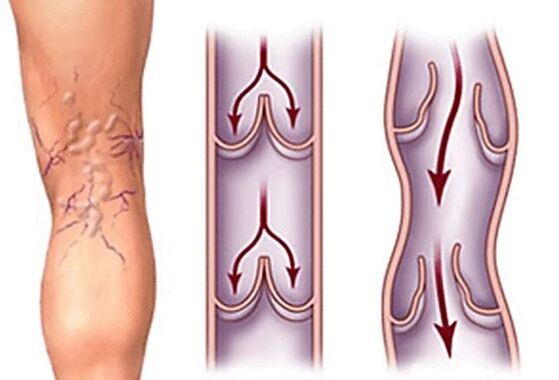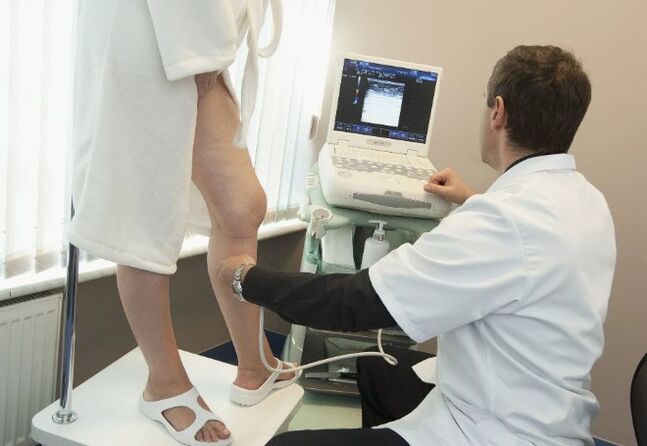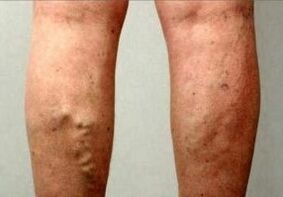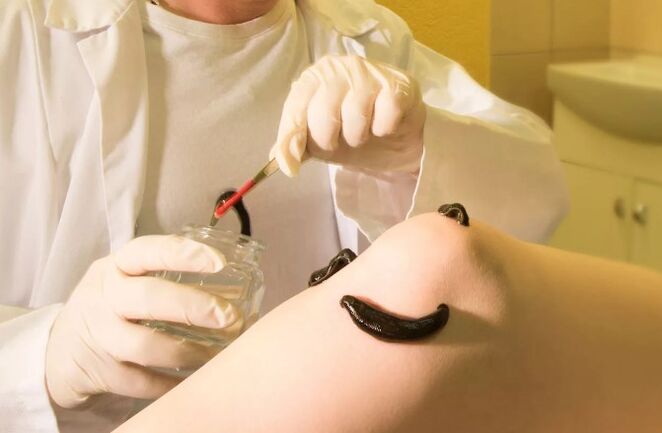Vascular diseases are a fairly common phenomenon that can happen to everyone. Like many other diseases, varicose veins have its phases and if the initial manifestations of the pathology are more often accompanied by the discomfort, the last stage is dangerous not only for health, but also for human life. To avoid the onset of serious consequences such as, for example, disability and others, it is necessary to know the main characteristics of the manifestation of varicose veins, its development and ways to prevent complications.

The concept of varicose veins
Varicose veins are a disease that affects the muscle layer and connective tissue of the vascular wall, as well as their valve apparatus. Consequently, the veins are expanded, the blood circulation in this place, the inverse blood of the blood through the vessels.
Many people know varicose veins standing. But there are other locations of the disease, since the vases can be affected anywhere in the body.
Very often, in medical practice, the varicose veins of the pelvic organs (bladder, uterus), perineum (scrotum, rectum, vagina) are diagnosed. However, in any case, the clinical picture of the disease depends on the place of the damage and the stage of the pathology.
Varicose veins in men and its characteristics
At a young age (on average, at 10-12 years), a young man can meet a disease like the varicose veins of the scrotum veins.In scientific, this state is called "Varicocele". It can be found during a simple exam and palpation of the scrotum. Clinically Varichocele manifests itself with a series of symptoms, which include:
- pain on the side or half of the scrotum concerned, intensifying after physical activity;
- gravity in the testicle;
- infertility.
However, often Varichocele may not show himself at all and be identified by chance during a planned exam.
This disease distinguishes three phases:
- Light expansion of the veins, which can be seen when the patient performs the Valsalva champion (tension);
- The veins are visible and palpate in a calm state of the patient;
- The ships are abruptly changed, convincing, full of blood. The testicle in the area affected by the disease is small in size, has a test consistency.
In adult patients, the varicose veins of a scrotum are often diagnosed in the treatment of a doctor with complaints of the inability to have a child. There is a theory on the basis of which the varicle affects fertility (the ability to reproduce the offspring) by increasing the temperature inside the scrotum, which negatively affects the testicle and spermatogenesis. In addition, this type of varicose veins in men is often combined with damage to the vases on the legs.

The diagnosis of the disease is simple. As mentioned above, it is possible to suspect the varicose veins of the scrotum on a normal examination and therefore an ultrasound study of the vascular radius should be done to confirm. As a method of treatment, only surgery is used: the doctor simply binds varicose veins, blood circulation is performed according to anastomosis. However, it should be borne in mind that, as with varicose veins, the operation does not guarantee complete healing. In addition, the disease in many cases is recurring.
Characteristics of varicose veins in women
Pelvic varicose veins.For women, this disease is a risk of inconvenience of the fetus. As mentioned above, varicose veins can occur on any part of the body, even in the pelvic area. During pregnancy, the situation is aggravated, since, first of all, the vessels of the abdominal cavity are lengthened as the fetus grows and secondly, the uterus that increases in size exerts pressure on them. Because of these processes, the blood -of -the -place circulation is disturbed, which can lead to its refusal. In this case, of course, the probability of losing a child increases significantly.
Sometimes the debut of varicose veins during pregnancy.Before conception, a woman could not suspect at all to have a tendency to disease. However, during the period of bearing the fetus, the female body is subject to certain changes in the body that can cause some diseases, including varicose veins. Such changes include:
- Change the hormonal background;
- increase in body weight;
- Anatomical changes.
In addition, the number of births is directly proportional to the risk of gaining a later pathology. In addition to the pelvic varicose veins, during pregnancy, other complications can occur:
- breakage of uterine veins during childbirth;
- thromboflebitis;
- dermatitis, trophic ulcers;
- venous deficiency.
Therefore, pregnancy is a factor that, unfortunately, can cause varicose veins, since it contributes to a faster development of the pathology and requires preventive measures with a certain diagnosis.
Other consequences of varicose veins
Thromboflebitis.Often varicose veins and venous deficiency lead to the inflammation of the walls of the blood vessels - phlebitis, which can be combined with the formation of blood clots - thromboflebitis. Basically, this disease affects the vessels of the lower limbs, due to whom patients complain of severe pain in the affected areas of the legs. The symptoms of a general inflammatory reaction are noted: high temperature, weakness. If the treatment is not started in time, the process applies to the other veins, the patient's conditions worsen.

Thromboembolism.In the presence of thrombophlebitis and varicose veins, there is a risk of serious complications - thromboembolism. It occurs due to the separation of the blood clot from the wall of the vase, followed by the blocking of the most important trunks that nourish the heart, light and brain.
Initially, a blood clot can be, for example, in the leg (this is the most common). However, from the lower limb, he is forced to move through the blood flow in various parts of the body. Consequently, falling into smaller branches of the vascular system, the blood clot causes a collapse, due to which the blood circulation of the site is disturbed by the appearance of ischemia and therefore to necrosis. Clinically, this manifests itself from a heart attack, a stroke or a lung fat (thromboembolism of the lung artery), which often puts an end to death.
The treatment of patients made of this diagnosis should be carried out only in intensive care units and intensive care. The measures to provide patient assistance in this case should be taken immediately - only in this case the patient has a possibility of salvation.
Dermatitis.Very often, this unpleasant complication occurs on the internal surface of the lower part of the leg, manifests itself as a series of symptoms, which include:
- thinning of the skin;
- epidermal pigmentation;
- itching of the affected area;
- the appearance of bubbles that tend to "open", which leads to the stratification of the skin;
- Violation of the sensitivity of the area concerned.
Dermatitis does not heal well, it can hardly be treated. The presence of a thrombus involves the presence of trophic ulcers - sections of skin death. In the future, an infection can combine the ulcers from which purulent wounds may appear.
Telegioectasia.This cosmetic defect, which resembles vascular "stars", is a consequence of the ruptures of small surface capillaries and a sign of the initial phase of varicose veins.
Hemorrhoids.This is a very common disease - nothing but varicose veins of the rectum. It manifests itself from the emergence of the hemorrhoidal nodes so called, which are often able to go out, break and inflame themselves. This causes significant concern for patients.
Diagnostic methods

The simplest and most convenient way to detect varicose veins and its complications are the ultrasound doppler veins of the lower ends. In the process of this study, the blood flow, the blood vessels and the conditions of their walls as a whole are assessed. Therefore, the above diagnosis helps to detect blood clots. In addition, all patients with varicose veins are necessary to pass Doppler before any surgery in order to exclude the presence of blood clots in order to avoid complications.
In cases where the patient is suspected of venous or thrombosis deficiency, doctors recommend the X -ray phlebography (the method for evaluating the work of the veins).
To do this, a special serum - the albumin is introduced into the ship, after which a X -ray is taken, on which impulses from the veins will be recorded. So the result is evaluated.
You can complete the exam with computerized tomography with the contrast of military trunks. This method is the most accurate, but more expensive. However, this method of diagnosis allows not only to identify vascular diseases, but also to evaluate the conditions of other systems and tissues of the body.
Treatment of complications
The therapy for the consequences of varicose veins depends on the current state of the patient and, directly, on the type of complication. Therefore, thromboflebitis requires the prescription of anti-inflammatory drugs, antibiotics, anti-inflammatory. As the inflammatory process mitigates, physiotherapy, Irudotherapy (treatment with leeches) is recommended). An operation can be proposed as a epotropic treatment: binding and removal of the vein.
Trophical ulcers are poorly treated.The surgeon removes the areas of necrosis, prescribes medications with an antiseptic and ointments. Together with these manipulations, antibacterial therapy and blood flow are performed in Vienna.
Vascular stars are eliminated from sclerotherapy, that is, the so -called "glued" of the light of the veins. After the procedure, the compression linen for the prevention of relapses is prescribed.
Other complications, such as hemorrhoids, varicoceles and varicose veins of the pelvis can be treated surgically only after an in -depth examination and identify the interested vein.
Forecast

An unfavorable prognosis is observed in the case of the thromboembolia of the lung artery, the number of deaths in which it reaches 75%. In addition, thrombophlebitis with trophic leather lesions has a non -escort feature, since with such a persistent change in the blood vessels with such a disease and the risk of infection has also increased, which leads to a series of complications. The consequences of the disease can often lead the patient to disability.
The indications for the supply of a patient for disability are:
- the presence of thrombosis and the transferred thromboembolism;
- Performant;
- Post -ombophlebitic syndrome;
- Ineffective surgical treatment.
Very often, disability is given to patients with the last phase of varicose veins with a persistent compromised performance.
























